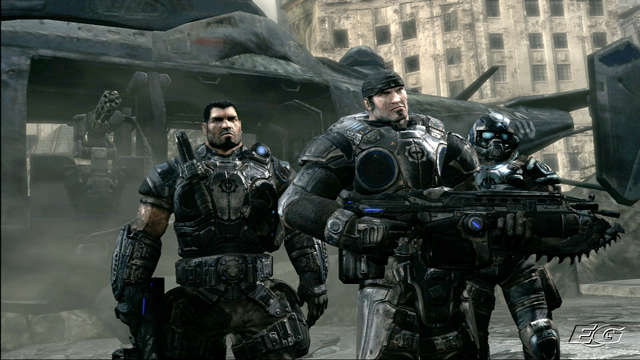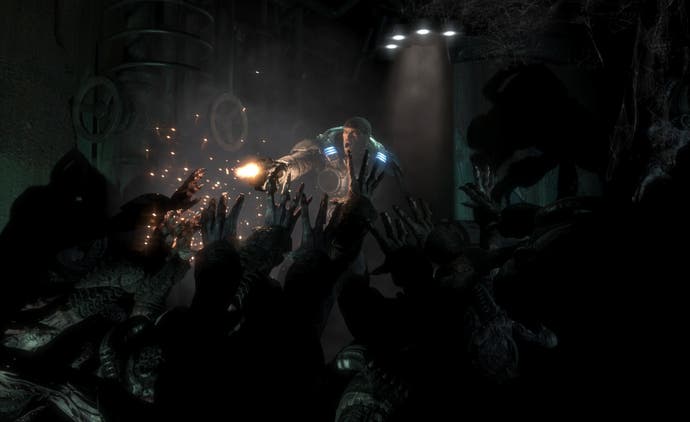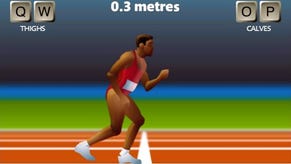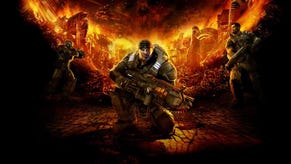Gears of War
And now the bit about multiplayer.
You can read what we made of the single-player campaign elsewhere on the site.
Gears of War's multiplayer could and should be one of the best online multiplayer gaming experiences around. Right now - when all the stars are aligned - it can be one of the most unique and entertaining, but also one of the most infuriating.
The raw material for you to go online and have a lot of fun is there in abundance. Key to this is the fact that the 10 multiplayer maps are so well designed and pleasantly varied. Based around various key environments that you'll be familiar with from the main campaign, there's genuinely not a bad one among them. Even if you're well versed with the story mode, the first time you play each one gives you that same feeling of wide-eyed awe that reminds us about that next generation we keep hearing so much about (but seeing so little of). But it's not just impressive in terms of stand-out graphical opulence (which is a given), it's the realisation of how well balanced most (if not all) the map are too, without ever resorting to lazy symmetrical designs.
Every map has a start point at opposing sides of the map, with the simple goal of taking out your opposite numbers. After every round you swap to the opposite side of the map, presumably to even out any possible advantage there might conceivably be, and so the match goes on until you reach the first to five - or however many rounds the host dictates. With just eight players supported, it's no surprise to find such tight, confined maps designed around columns and cover points. Encounters with the enemy usually take place within a matter of 10 or 20 seconds, so it's normal to find your opponents all rushing to take up the best spots to pick you off. Anticipation of that tends to be key, so the turnover of rounds can happen in a matter of a few minutes, and as a result you get a really good appreciation of the entire map in no time at all. By design, Gears of War's multiplayer experience is an instantly accessible experience, and yet tough to master.
Nice arsenal

Part of the reason it's tough to master is working out the best use of which weapon at the right time. Weapon loadout is the same for both the Locusts and the Cog troops, and no side has an real advantage in terms of better weapons or superior health or speed and so on. You all start with a single smoke grenade, the Snub pistol, the Lancer assault rifle (complete with chainsaw bayonet for super-satisfying melee kills), and the short-range Gnasher, and whether you choose to grab any of the other more powerful specialist weapons lying around the map is up to you, but definitely helps. Different maps offer specific weapons, such as the Boomer grenade launcher, the Longshot sniper rifle, or (most commonly) frag grenades, while others might allow you to wield the satellite-enabled Hammer of Dawn (that shoots down a particle beam from the sky) as well as others featured in the campaign mode. But, generally, every weapon has its own set of massive disadvantages. For example, the sniper rifle might be deadly enough to kill a player in one shot, but its load time leaves a player exposed for a dangerous amount of time. Similarly, the shotgun's useless at long range, but absolutely deadly from three metres away, and while the assault rifle is useful at long range, its chainsaw bayonet can catch a player off guard in grisly fashion.
One thing you'll also notice early on is how some maps are more suited to certain weapons than others. For example, the long, narrow Canal map with its various bridges makes it a popular choice for snipers, while others (like the one with the central decaying mansion) favour a more condensed multi-layered approach with doorways offering excellent choke point opportunities for you to lay in wait for the unsuspecting foe with the Boomer primed and ready.

Perhaps the thing that takes the most adjusting to is the fact that there's a much greater emphasis on close quarters combat in multiplayer - which simply wasn't such a big deal in the campaign mode where most enemies tended to sit patiently behind cover and pop out obligingly. For a while you might assume the same tactics will work online, where you could zoom in on targets and kill them with a few well-placed shots from your Lancer - but you'll come completely unstuck if you do. Suddenly you'll start to make much better use of blind firing that you ever did before, and appreciate the usefulness of the melee grenade attack, or how essential the Gnasher really is.
Morning glory
Because of the game's rather limited AI scope in campaign mode (even in Hardcore mode), none of these techniques were ever really called for that often (if ever), but playing it in multiplayer really starts to reveal how finely balanced the weapons are, and how using the environment properly is essential. In fact, the entire control system seems much more tailored to the demands of multiplayer conflict, where evasion techniques are paramount. In conjunction with the same recharging health mechanic, a skilful player can roll away from an attack, and perform cover slips and SWAT turns to their advantage. A beginner may make good use of cover, but in these desperate situations a good knowledge of the right weapons to use and how to get yourself out of trouble makes for an interesting battle.

It's perhaps here that Gears of War can truly start to assert its differentials over the online shooting herd, with a style of multiplayer gaming that does feel somewhat fresh in comparison to a lot of the done-to-death first-person shooters that have been trawled out endlessly. And even against more serious squad games like GRAW, it bothers to make use-of-cover an essential part of the gameplay - something Ubisoft bizarrely stripped out of the multiplayer after basing the entire single-player gameplay on exactly that. At least there's a real consistency in GoW, in that the multiplayer game doesn't feel annexed in any way from the campaign.
The controls, while by no means perfect and easy to get tangled in knots with, at least attempt new things that have a major impact on how multiplayer games play out. The active reload system, for example, is an excellent idea that gives players the chance to reload much quicker by mastering a very simple and effective technique of double-tapping the reload button at precisely the right time. Being able to do this in the heat of battle can make the difference between life and death, as can being able to exit cover and mount low walls in one fluid motion. Put these small things together and you have a game which offers something a little different in many areas. Other shooters have never really nailed that sense of physical interaction with the environment, resorting to crouch and lean options that never really felt right. I wouldn't quite go as far to say Gears of War feels right either, because Epic has introduced enough annoying quirks of its own, to be fair (such as how clunky the whole running mechanic is, for a start), but at least CliffyB and co have tried to offer a different approach.







